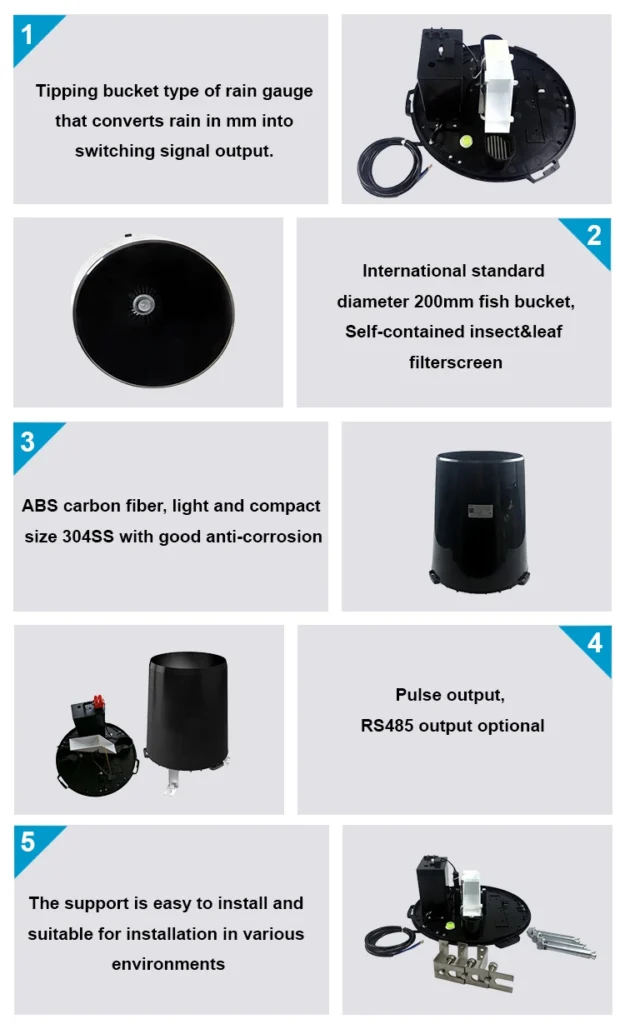rainfall measuring & how to measure rain inches & weather station with rain gauge
In recent years, home weather stations have become popular. Homeowners, weather fans, and gardeners all enjoy using them. These small and simple devices let you check the weather at home.
One of their main jobs is to measure inches or millimeters of rainfall rate. Understanding how these weather stations do this can help users use them better. This knowledge can help them get ready for different weather situations.
Common Rainfall Measurement Methods in Home Weather Stations
The two most common methods used by home weather stations to measure rainfall are tipping-bucket and weighing techniques. Each method works in its own way and has special features.
Tipping – Bucket Method
The tipping-bucket rain gauge is a common choice for many home weather station with rain gauge. It is simple, reliable, and cost-effective. At the center of this system is a small, bucket-shaped container. It tips when a certain amount of rainwater collects inside.
Structure and Operation: The tipping-bucket mechanism has two buckets that balance on a pivot. As rain falls into a bucket, it slowly fills up. When the water supply reaches a certain level, it shows how much rain has fallen.
You can measure precipitation this amount as 0.01 inches or 0.2 millimeters. It depends on how you set the gauge. Then, the bucket tips over. This action serves two purposes.
First, it drains the collected water. This prepares the bucket for the next rain. Next, it sends an electrical signal.
Signal Detection and Data Conversion
A sensor in the weather station picks up an electrical signal. This signal happens when the tipping action takes place. This sensor can be a simple switch, a magnetic reed switch, or a more advanced sensor. The system then sends the signal to the main processing unit of the professional weather stations.
The processing unit counts how many times the bucket tips over in a set time. The weather station can find the total heavy rainfall. It does this by knowing how much water level causes each tip and how many tips there are.
For example, each tip measures 0.01 inches of rain. If the bucket tips 10 times in an hour, that means the total rainfall is 0.1 inches.
Weighing – Based Method
Some high-end home weather stations use a weighing rain gauge to measure rainfall. This gives them great accuracy and lets them detect even small amounts of rain measurements.
In a weighing-based rain gauge, rainwater collects in a container. This container is on a sensitive scale or load cell. As rain fills the container, the weight of the water goes up.
The weighing scale keeps track of weight changes. It turns these changes into an electrical signal. This signal shows how much water has been collected.
The weighing scale sends the electrical signal to the weather station’s processing unit. The program in the processing unit converts the change in weight into a measurement of rainfall. This conversion considers the density of water.
One gram of water takes up one milliliter of space. It also looks at the area of the container that collects rain. The weather station uses these factors to measure how much it rains. This gives precise measurements, often better than tipping-bucket gauges, especially for light rain.
Additional Considerations and Features
Calibration: To get accurate amount of rainfall measurements, home weather stations need regular calibration. This applies to both tipping-bucket and weighing-based types of rain gauges. Manufacturers often give instructions on how to calibrate the gauges.
This may involve changing the tipping-bucket mechanism or adjusting the weighing scale. Calibration helps adjust for changes in how the gauge works over time. This includes damage from use or changes in the environment.
Placement: The placement of the standardized rain gauge in your home weather station is very important for getting accurate readings. You should put it in an open area. Keep it away from things like trees, buildings, or other structures. These can block the rain fell or make it splash into the gauge.
This can lead to wrong measurements. You should place the gauge at a good height. It should be at least a few feet above the ground. This helps avoid problems from things at ground level.
Collected data Transmission and Display: Most modern home weather stations can send real time data without wires. This lets rainfall data go to a central display unit or to a smartphone or computer using Wi-Fi or Bluetooth.
The display unit shows current rainfall amounts and past data. This helps users see how rainfall changes over time. They can look at trends and make good choices using weather data.
conclusion
Home weather stations use simple methods to measure rainfall. The most common methods are tipping-bucket and weighing techniques. These methods, along with good calibration and proper placement, help homeowners and weather stations measure rain. This helps them learn about local weather and how it impacts their daily life.
